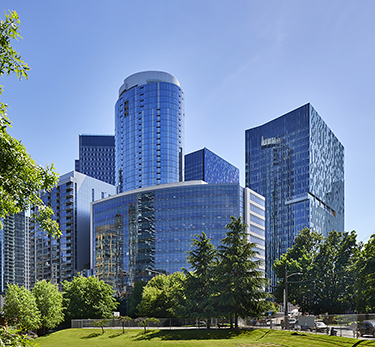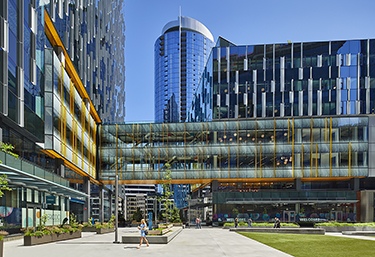|
Subscribe / Renew |
|
|
Contact Us |
|
| ► Subscribe to our Free Weekly Newsletter | |
| home | Welcome, sign in or click here to subscribe. | login |
Environment
| |
 |
April 25, 2024
Harnessing the potential of mixed-use communities
Graphite Design Group

DiRaimo
|
Mixed-use communities are the future of urban centers like Seattle. The revitalization of Seattle’s Denny Regrade neighborhood acts as a model of sustainable urban development as it was designed with the principles of resource conservation, transportation synergies, lifestyle benefits and long-term flexibility at the center.
Graphite designed 6 buildings within a 4-block area that serve the neighborhood and offer residential, commercial office, retail, and public amenities including childcare, dog parks, and public art.
DOING MORE WITH LESS
The revitalization of Seattle’s Denny regrade neighborhood employed vertical density to increase overall site utilization and reduce the amount of area required to house these functions as compared to horizontal, single-use models where each program element may be in an individual building. Building mechanical elements are consolidated within the subterranean garages and rooftops, freeing up the ground plane for open space, circulation and active uses, while the towers above maintain high efficiency and program flexibility. The result is the ability to fit more value within a smaller container, doing more with less.
Experiential and lifestyle benefits accompany this community-driven sustainable approach. Buildings contain uses that activate the neighborhood throughout the day. While traditional single-use properties typically see peak intensity that cycles with their use—office during business hours, retail and residential in evenings and weekends, open space activity that varies with weather and season—the mixed-use Denny Triangle neighborhood blends these uses to provide engagement and activation on complimentary cycles. The same workers who occupy offices during the day may also live in one of the on-site residences and take advantage of the diverse retail and service offerings. This all contributes to a healthier, happier urban environment, promoting the goal of truly livable cities. By offering this diversity on site and convenient connections to adjacent uses, transportation demands are also reduced as there is less need to travel to attend to the needs of daily life.
DESIGNING FOR DENSITY AND VARIETY
Our core strength is being flexible in the design of buildings with density and variety. Varying from integrated uses, scale of development, or complexity of mixing housing, retail, offices, and amenity spaces, Graphite excels at problem-solving the fundamental challenges of making mixed-use projects successful.
The Denny Regrade features an abundance of housing and offices keeping activity around the clock, and supplements foot traffic with 85,000 square feet of retail. The retail is supported by this dense neighborhood and offers building occupants and residents retail needs in the form of home goods, food and beverages, fine dining, clothing, banking, grocery stores, bike shops and other general sales.
Occupants of mixed-use buildings reduce their energy and water use, and lower their carbon emissions by taking up less space and being centrally located. With access to transit and neighborhood businesses, these buildings become the economic engine for the city contributing to Denny Triangle’s 24/7/365 activation.
Understanding the variety of mixed-use, it is essential to calibrate building layouts and infrastructure to support a wide range of uses. Whether it’s an office environment capable of absorbing housing or shifting the space to hospitality in the event markets change, our core belief is that the most sustainable building is the one most flexible to last.
MAKING CRITICAL LAST-MILE CONNECTIONS
As it is located in downtown Seattle, the Denny Regrade neighborhood is inherently well-served by close proximity to regional transit networks, including protected bike lanes, the Rapid Ride bus system, the streetcar and future light rail expansion projects. This gives those who choose to live and work on site the opportunity to stay connected without the need for a car, reducing single-driver trips and their related emissions, as well as lessening demands on road infrastructure.
Additionally, numerous site-specific community transportation solutions have been integrated into the design of the properties themselves, helping address the critical “last mile” connection between broader networks and the places people live & work. These include:
• South Lake Union Streetcar line with stop at 2201 Westlake
• King County Metro stop on 7th Avenue
• Protected bike lane on 7th Avenue and Bell Street
• Expansive cycling facilities on site, with prominent entries designed to welcome bike commuters.
These transportation solutions are not merely a convenience to residents; they provide critical connectivity to schools, hospitals, grocery stores, parks, and other regional destinations that support urban lifestyles for residents who live in the city but choose not to drive every day.
Functional elements of the buildings in the Denny Triangle have been designed to support density while minimizing resource use. Mechanical systems in all the buildings employ state-of-the art technology to condition spaces efficiently while providing dedicated fresh air to occupants and operable windows, increasing health and well-being, creating an eco-community.
Where programs are shared within one building, further efficiencies are attained. At 2201 Westlake/ Enso, waste heat that is a byproduct from cooling the office space is captured and reused to heat domestic water for the condominium units. Broader neighborhood strategies are also key, as both Amazon Nitro and Frontier have been designed to tap into a hot water loop that circulates and stores excess heat energy from an adjacent high-rise data center to offset on-site heating and conditioning loads.
Mixed-use buildings reduce our building footprints, reduce our resource needs, and reduce our emissions. As populations continue to urbanize and downtowns begin to diversify, designers should equip themselves to deliver a sustainable solution though thoughtful mixed-use design.
Ryan DiRaimo, is the director of sustainability at Graphite Design Group, a member of the Northwest Design Review Board and contributor to the Aurora Reimagined Coalition.
Other Stories:
- Creativity and innovation are hallmarks of sustainability at PDX Airport
- Curbing construction’s carbon impact from all angles
- Making old buildings new again: the case for adaptive reuse
- Promoting residential adaptive reuse in Seattle through policy
- Hiding in Plain Sight: Sustainability and resilience beyond the terminal
- Reducing embodied carbon in concrete construction
- Old building, new tricks: Designing adaptive reuse for long-lasting relevance
- Implementing aggressive water goals
- A blueprint for environmental responsibility in construction
- A primer on campus decarbonization in Washington
- Toward a path to zero carbon: building renovations and circular economy principles




